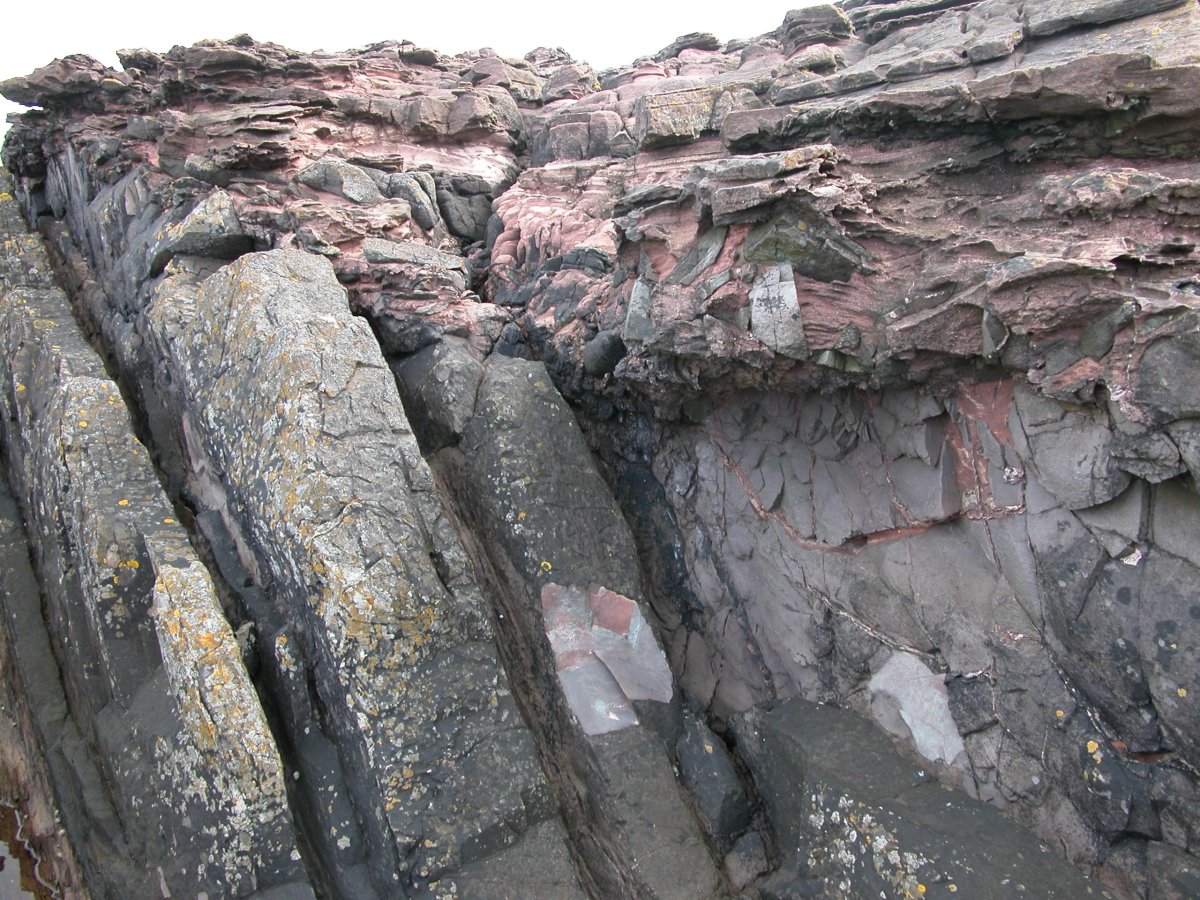
Siccar Point UnconformityIt is not uncommon for near-horizontal sandstones to unconformably cap tilted or folded sediments. One of the most famous examples of sandstone overlying steeply tilted strata occurs at Siccar Point on the east coast of Scotland. The rock formation evident here was interpreted in the eighteenth century by James Hutton as an unconformity, that he suggested indicated warping and deformation of sediments originally deposited in horizontal layers, and their uplift and erosion over immense periods of time, followed by deposition of sands above the eroded, tilted strata at the bottom of the sea, and uplift to its present position. Perhaps the rocks exposed at Siccar Point are more simply explained as due to a process of progressive in situ alteration of the tilted greywakes, that involved crystallization of silia that they contained, as the sediments were compacted. The result was the formation of successive layers of cross strata. Other than the prevalence of Hutton's dogma and geologic tradition, there seems to be little reason not to consider whether the true explanation involves reconstitution of the greywacke rocks into sandstone, during unloading due to uplift and erosion of overlying sediments. There are two fundamendal interpretations of the significance of the unconformity at Siccar Point:
One way to test alternative hypotheses is to consider what predictions can be made from each point of view, and check whether the facts tend to confirm or discredit one or the other. At Siccar Point, the cross strata in the overlying sandstone was formed either by a sedimentary process, thought to involve high energy, and fast currents capable of transporting gravel, or it was formed at depth by a descending front of chemical alteration and crystallization of silica of the tilted greywacke strata in near-horizontal layers as other components of the sediment were organized into concretionary nodules that became pebbles in the sandstone. In the sedimentary environment, fast currents imply the surface of the greywacke would be streamlined. The currents would cause directional features; erosion of troughs on the stoss or up-current side of obstacles, and deposition of "tails" of sediment or "current shadows" on the lee side of obstacles. The in situ transformation theory predicts these directional effects and evidence of streamlining at the contact would be absent, as no currents were involved in the formation of the patterns of cross strata. The previous photo, and the one below show no sign of streamlining of the top surface of the tilted greywacke at the base of the sandstone, but the surface is irregular, which seems to discredit Hutton's view and favors an in situ alteration interpretation. |

| The image below shows a close-up of the contact
between the greywacke and sandstone at Siccar Point. The blocks of
original greywacke embedded in sandstone are angular in this view,
suggesting there was no streamlining by fast currents, and there are no
indications of currents having caused directional features such as
lee-side "current shadows" or sediment tails around obstacles. In the in situ alteration interpretation
they are simply rocks left unaffected by the process of
alteration. The sandstone may include pebbles of concretionary
origin that were also left intact during the transformation of
greywacke to sandstone. If features such as streamlining and current shadows were present, I would be forced to abandon my in situ interpretation of the formation of cross strata in sandstones and the drift. It is remarkable that although many people visit Siccar Point to view these rocks, apparently none have thought to check whether they in fact support the interpretation proposed by Hutton, by identifying the current shadows on the lee side of obstacles, etc. that his interpretation predicts. The site is billed as one of the top 10 geological sites in the UK. |

Images of Siccar Point Here you can view some larger images of the Siccar Point rocks by Dr Ford and several more
Revising
Hutton's Unconformities A Creationist discussion of the
significance of the Siccar Point unconformity
Time to Re-examine our Assumptions about Cross Strata?